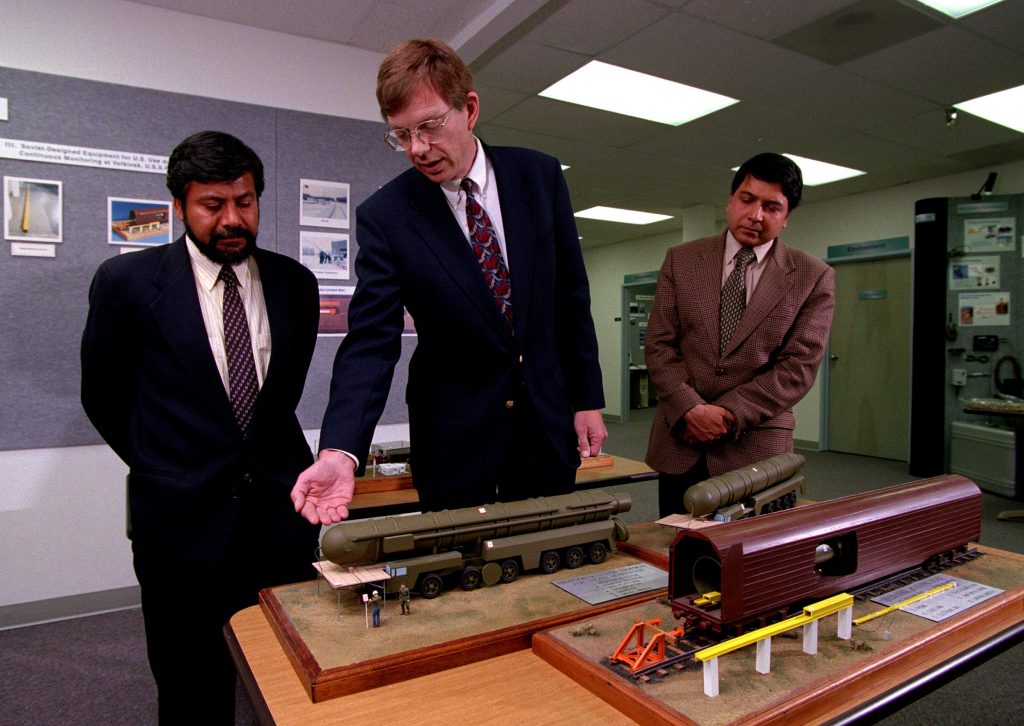
Download 300dpi JPEG image, ‘cmc-scholars.jpg’, 1MB (Media are welcome to download/publish this image with related news stories.)
ALBUQUERQUE, N.M. — Sandia National Laboratories’ Cooperative Monitoring Center (CMC) celebrates its 10th anniversary on Thursday, July 29, with a series of speakers that reflect the Center’s international missions. (See speakers list below.)
The CMC was established in 1994 after members of Sandia’s technical staff recognized that technology could be an important element of confidence-building measures or treaties that build trust among nations. They also believed, long before it was widely accepted, that improving regional security around the world was integral to U.S. national security.
They proposed to make available to the world — and particularly to Middle Eastern nations engaged in regional conflicts — sharable technologies and information that could become part of such tension-reducing arms control agreements. The CMC initially served as a demonstration facility where experts from around the world came together to learn about such technologies.
Today, with funding from the Department of Energy’s National Nuclear Security Administration, the CMC supports U.S. nonproliferation efforts, leads Sandia programs to protect weapons-usable materials around the world, supports the International Atomic Energy Agency’s nuclear safeguards work, helps former Soviet nations secure and dismantle nuclear weapons, develops border monitoring technologies, proposes processes to inspect U.S.-destined shipping containers in foreign ports, secures thousands of radiation sources around the world, improves regional security through scientific and technical engagement projects, and leads international efforts to develop standards for protecting potentially dangerous biological pathogens.
Its staff works with officials representing a broad spectrum of U.S. agencies and foreign governments. Representatives from 127 countries, ranging from senior government officials to staff-level technical experts and graduate students, have toured the CMC’s technology training and demonstration area.
Representatives from 12 countries have been trained in cooperative monitoring concepts and system design. And last year the CMC established a sister CMC facility in Amman, Jordan, led by Sandia but staffed by Jordanians.
The CMC’s staff now works in a 65,000-square-foot, three-story building outside the Eubank Gate to Kirtland Air Force Base, in the Sandia Science and Technology Park. Approximately 500 Sandia employees support the Center’s work.
Key speakers for CMC’s 10th anniversary, Thursday, July 29
Ambassador Shirin Tahir-Kheli, Special Assistant to the U.S. President, Senior Director for Democracy, Human Rights, and International Operations, National Security Council
Kurt Siemon, Office of Defense Nuclear Nonproliferation, National Nuclear Security Administration
Scott Davis, Office of Nonproliferation Policy, National Nuclear Security Administration
Karin Foster, Office of U.S. Rep. Heather Wilson
Mohammad Shiyyab, Director, CMC-Amman, Amman, Jordan, Sandia National Laboratories
Naoko Inoue Nakashima, Nuclear Engineer, Nuclear Cycle Development Institute, Japan
Mahmud Durrani, Consultant on Defense and International Affairs, Pakistan German Smirnov, Chief Designer, All Russian Research Institute for Automatics, Russia
Al Romig, Vice President, National Security and Arms Control, Sandia National Laboratories
Dori Ellis, Director, International Programs Center, Sandia National Laboratories
Arian Pregenzer, Senior Scientist, Cooperative Monitoring Center, Sandia National Laboratories